|
|
 |
|
Calanoida ( Order ) |
|
|
|
Clausocalanoidea ( Superfamily ) |
|
|
|
Euchaetidae ( Family ) |
|
|
|
Euchaeta ( Genus ) |
|
|
| |
Euchaeta concinna Dana, 1849 (F,M) | |
| | | | | | | Syn.: | Euchäta concinna Giesbrecht, 1892 (p.246, 263, 772, figs.F,M);
Paraeuchaeta concinna : Bradford & al., 1983 (p.33, figs.F,M, Rem.); Othman & al., 1990 (p.561, 563, Table 1); Chihara & Murano, 1997 (p.799, Pl.105,111: F,M); Nakajima & al., 2015 (p.19, Table 3: abundance);
Pareuchaeta concinna : Othman & al., 1990 (p.561, 563, Table 1); McKinnon & al., 2008 (p.844: Table.1);
Euchaeta consimilis Farran, 1936 a (p.90, figs.F, Rem.); Sewell, 1947 (p.116, Rem.); 1948 (p.426); Rose, 1955 (p.391); 1956 (p.460); Saraswathy, 1966 (1967) (p.77); Stephen, 1984 (p.161, 169, distribution vs thermocline); Othman & al., 1990 (p.565, Rem.);
no E. concinna (F) : C.B. Wilson, 1950 (p.212, figs.F, ?M) | | | | Ref.: | | | Giesbrecht & Schmeil, 1898 (p.39, Rem. F,M); Thompson & Scott, 1903 (p.234, 244); A. Scott, 1909 (p.65, figs.F,M); Wolfenden, 1911 (p.299); Sewell, 1912 (p.353, 360); 1914 a (p.216); 1929 (p.133, 146, Rem.); Farran, 1936 a (p.90, fig.F, Rem.); Mori, 1937 (1964) (p.45, figs.F); Dakin & Colefax, 1940 (p.99, figs.F,M); Pesta, 1943 (p.16, figs.M); Chiba & al., 1957 (p.308); 1957 a (p.11); Tanaka, 1958 (p.328); Grice, 1962 (p.201, figs.F,M, Rem.); Kasturirangan, 1963 (p.29, figs.F,M); Chen & Zhang, 1965 (p.54, 130: Rem., figs.F,M); Tanaka & Omori, 1968 (p.220); Tanaka, 1973 (p.132, figs.F,M); Chen & Shen, 1974 (p.125, 127, figs.M); Greenwood, 1977 (p.55); Kimmerer & al., 1985 (p.426); Zheng Zhong & al., 1989 (p.238, figs.F,M); Park, 1995 (p.18, Redescr.F,M, figs.F,M); Bradford-Grieve & al., 1999 (p.880, 925, figs.F,M); Al-Yamani & Prusova, 2003 (p.51, figs.F,M); Mulyadi, 2004 (p.68, figs.F, Rem.); Vives & Shmeleva, 2007 (p.648, figs.F,M, Rem.); Phukham, 2008 (p.131, figs.F, M); Al-Yamani & al., 2011 (p.38, figs.F,M); Jeong & al., 2011 (p.117, 123, figs.F,M, Rem.; genital aperture); Soh & al., 2013 (p.15, figs.F,M) | 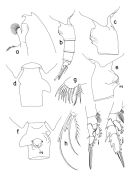 issued from : T. Park in Bull. Scripps Inst. Oceanogr. Univ. California, San Diego, 1995, 29. [p.117, Fig.7]. Female: a, forehead (left side); b, urosome (left side); c, genital somite (left side); d, idem (dorsal view); e, idem (right side); f, idem (ventral view); g, first inner lobe of Mx1 (posterior view); h, endopod of Mx2; i, first leg (anterior view); j, second leg; crg = central ridge of genital operculum. Nota: Laterally, dorsal margin of forehead only slightly arched. Frontal eminence large and conical. Rostrum small, strongly curved backward. Dorsally, posterolateral corners of prosome angular, asymmetrical, left side being much longer. Laterally, left distal margin of prosome produced into lappet pointing in a dorsodistal direction. Dorsally as well as ventrally, genital somite strongly asymmetrical, with a large toothlike outgrowth midway along right side and a conspicuous notch on left side about 2/5 length of somite from proximal end. The large toothlike outgrowth of the right side produced ventrally to form right genital flange. Posterior edge of genital field is defined by a structure appearing in lateral view like a conical process and in ventral view like a ridge on the right sife. Left genital flange in lateral view appearing like a large arc followed by a small rounded ridge and in ventral view like an ear-shaped structure. Central ridge of genital operculum visible in lateral view, developed as a toothlike process pointing backward. Appendicular and marginal setae of caudal ramus as in E. marina. A1 extending beyond distal end of prosome by its last 3 segments. In morphological details, A1, A2, Md, and Mxp show no significant differences from those of E. marina. Mx1 similar to those of E. marina except that 1st inner lobe with 1+8+1 setae. Mx2 similar to those of E. marina except 1st endopodal seta armed with long spinules in addition to very small spinules. P1, P3 and P4 similar to those of E. marina. In P2 exopod, outer spine of 2nd segment large, overreaching following outer spine. Marginal lobe bearing outer spine of 2nd segment also large, separated from segment by a deep incision; all other outer spines of similarly small size.
|
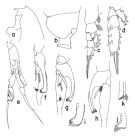 issued from : T. Park in Bull. Scripps Inst. Oceanogr. Univ. California, San Diego, 1995, 29. [p.118, Fig.8]. Male: a, forehead (left side); b, last pedigerous and genital somites (left side); c, first leg (anterior view); d, second leg (anterior view, protopod omitted); e, fifth legs (viewved from right side); f, exopod of left fifth leg (anterior view); g, idem (medial, tilted counterclockwise); h, idem (lateral view); i, distal end of serrated lamella (anterior view); j, idem (anterior view, tilted clockwise); k, idem (lateral view).
|
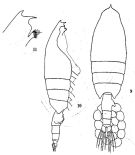 issued from: Q.-c Chen & S.-z. Zhang in Studia Marina Sinica, 1965, 7. [Pl.14, 9-11]. As Forma typica. Female (from E China Sea): 9, habitus (dorsal); 10, idem (lateral right side); 11, forehead (lateral).
|
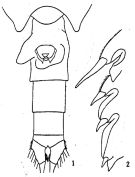 issued from: Q.-c Chen & S.-z. Zhang in Studia Marina Sinica, 1965, 7. [Pl.15, 1-2]. As Forma typica. Female: 1, urosome (ventral); 2, outer marginal spines of 3rd exopodal segment of left P2 (posterior)..
|
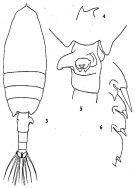 issued from: Q.-c Chen & S.-z. Zhang in Studia Marina Sinica, 1965, 7. [Pl.15, 3-6]. As Forma consimilis. Female (from E China Sea): 3, habitus (dorsal); 4, forehead (lateral); 5, genital segment (ventral); 6, outer magginal spines of 3rd exopodal segment of right P2 (posterior).
|
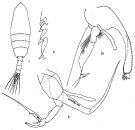 issued from: Q.-c Chen & S.-z. Zhang in Studia Marina Sinica, 1965, 7. [Pl.15, 7-10 ]. Male (from E China Sea): 7, habitus (dorsal); 8, outer marginal spines of 2nd and 3rd exopodal segments of left P2 (posterior); 9, P5 (anterior); 10, 2nd exopodal segment of left P5 (anterior).
|
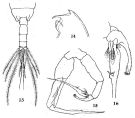 issued from : Q.-c Chen & C.-j. Shen in Studia Marina Sinica, 1974, 9. [p.128, Figs.13-16]. Male: 13, last thoracic segments and urosome (dorsal); 14, forehead (lateral); 15, P5; 16, exopod of left P5 (medial).
|
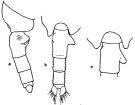 Issued from : G.P. Farran in Great Barrier Reef Expedition 1928-1929, Scient. Rep., V, N°3, 1936. [p.90, Fig.6]. As Euchaeta consimilis. a, abdomen (lateral); b, idem (dorsal); c, genital segment of E. concinna.
|
 issued from : A. Scott in Siboga-Expedition, 1909, XIX a. [Plate XIX, Figs.21-27]. Female (from Indonesia-Malaysia): 21, Mxp (end hair); 22, P1 (exopodite only); 23, P2 (outer margin of exopodite); 24, part of terminal spine of exopodite of P3. Male: 25, P1 (exopodite only); 26, P2 (outer margin of exopodite); 27, P5 (part of left leg).
|
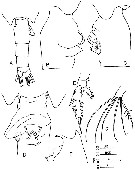 issued from : F.Y. Al-Yamani & I. Prusova in Common Copepods Northwestern Arabian Gulf : Identification Guide. Kuwait Institute for Scientific Research, 2003. [p.50, Fig.17]. Female: A, urosome (dorsal); B, genital segment (lateral right side); C, idem (left side); D, idem (ventral); E, P2; F, forehead (lateral); G, endopod of Mx2.
|
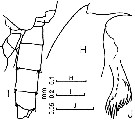 issued from : F.Y. Al-Yamani & I. Prusova in Common Copepods Northwestern Arabian Gulf : Identification Guide. Kuwait Institute for Scientific Research, 2003. [p.52, Fig.18]. Male: I, urosome (lateral left side); H, forehead (lateral); J, left P5 (distal end of serrayed lamella of exopod).
|
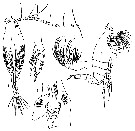 issued from : T. Mori in The pelagic Copepoda from the neighbouring waters of Japan, 1937 (2nd edit., 1964). [Pl.20, Figs.1-5]. Female: 1, 4, habitus (dorsal and lateral, respectively); 2, P2; 3, Mx2; 5, genital segment (ventral).
|
 issued from : G.D. Grice in Fish. Bull. Fish and Wildl. Ser., 1962, 61. [p.202, Pl.14, Figs.10-13]. Female (from 00°29'N, 139°49'E): 1-2, habitus (dorsal and lateral, respectively); 3, posterior part of thorax and genital segment (left side); 4, same (right side); 5, same (ventral); 6, P1; 7, P2; 8, P3; 9, P4. Male: 10-11, habitus (dorsal and lateral); 12, P2; 13, terminal part of left P5. Nota from Bradford & al. (1983, p.35): P1 exopod female: - Bb = 2/3 BC; Cc > BC.
- P2 exopod female: Aa ±Ab; Bb = 1/3 BC; Cc = 1/4 BC; Dd = 1/5 CD.
- P1 exopod male: Bb = 1/2 BC; Cc > 1/2 BC.
- P2 exopod male: Aa = 1/3 AB; Bb = 1/3 BC; Cc = 1/2 CD; Dd = 1/3 CD. (see code of lengths outer spines in the Genus' figure, or in Paraeuchaeta sp. A).
|
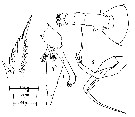 issued from : J.G. Greenwood in Proc. R. Soc. Qd, 1977, 88. [p.56, Fig.3, f-i]. Female (from 27°20'S, 153°15'E): f, 5th thoracic segment and urosome (dorsal). Male: g, P5; h, detail exopodal segment 2 of P5; i, exopodal segment 3 of P2.
|
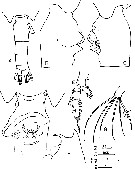 issued from : Y. Al-Yamani, V. Skryabin, A. Gubanova, S. khvorov & I. Prusova in Marine Zooplankton Parctical Guide for the Northwestern Arabian Gulf, 2, 2011 [p.38, Fig.154]. Female (from Kuwait): A, Urosome; B-C, genital double-somite (right lateral and left lateral views, respectively); D, genital area (ventral); E, P2; F, forehead (lateral); G, endopod of Mx2.
|
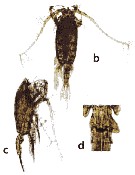 issued from : Y. Al-Yamani, V. Skryabin, A. Gubanova, S. khvorov & I. Prusova in Marine Zooplankton Practical Guide for the Northwestern Arabian Gulf, 2, 2011. [p.39, Fig.156, b-d] Female: b-c, habitus (dorsal and right lateral, respectively); d, genital segment (dorsal).
|
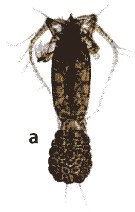 issued from : Y. Al-Yamani, V. Skryabin, A. Gubanova, S. khvorov & I. Prusova in Marine Zooplankton Practical Guide for the Northwestern Arabian Gulf, 2, 2011. [p.39, Fig.156, a]. Female: a, habitus with eggs sac (dorsal view).
|
 issued from : Y. Al-Yamani, V. Skryabin, A. Gubanova, S. khvorov & I. Prusova in Marine Zooplankton Practical Guide for the Northwestern Arabian Gulf, 2, 2011 [p.39, Fig.156]. Male: H, forehead (lateral); I, last thoracic somite and urosome (left lateral view); J, distal end of serrated lamella of exopod of left P5.
|
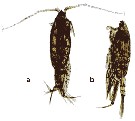 issued from : Y. Al-Yamani, V. Skryabin, A. Gubanova, S. khvorov & I. Prusova in Marine Zooplankton Practical Guide for the Northwestern Arabian Gulf, 2, 2011 [p.39, Fig.157]. Male: a-b, habitus (dorsal and left lateral, respectively).
|
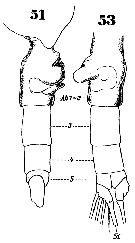 Issued from : W. Giesbrecht in Systematik und Faunistik der Pelagischen Copepoden des Golfes von Neapel und der angrenzenden Meeres-Abschnitte. - Fauna Flora Golf. Neapel, 1892, 19 , Atlas von 54 Tafeln. [Taf.37, Figs.51, 53]. As Euchäta concinna. Female: 51, urosome (lateral); 53, same (ventral).
|
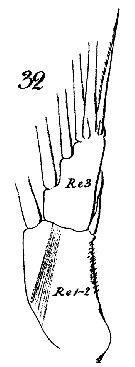 Issued from : W. Giesbrecht in Systematik und Faunistik der Pelagischen Copepoden des Golfes von Neapel und der angrenzenden Meeres-Abschnitte. - Fauna Flora Golf. Neapel, 1892, 19 , Atlas von 54 Tafeln. [Taf.15, Fig.32]. As Euchäta concinna. Female: 32, exopod of P1 (posterior view)..
|
 Issued from : W. Giesbrecht in Systematik und Faunistik der Pelagischen Copepoden des Golfes von Neapel und der angrenzenden Meeres-Abschnitte. - Fauna Flora Golf. Neapel, 1892, 19 , Atlas von 54 Tafeln. [Taf.16, Fig.40]. As Euchäta concinna. Female: 40, exopodite 2 and 3 of P2 (posterior view).
|
 Issued from : W. Giesbrecht in Systematik und Faunistik der Pelagischen Copepoden des Golfes von Neapel und der angrenzenden Meeres-Abschnitte. - Fauna Flora Golf. Neapel, 1892, 19 , Atlas von 54 Tafeln. [Taf.16, Fig.19]. As Euchäta concinna. Male: 19, exopodite 2 and 3 of left P5.
|
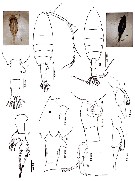 issued from : N. Phukham in Species diversity of calanoid copepods in Thai waters, Andaman Sea (Master of Science, Univ. Bangkok). 2008. [p.211, Fig.85]. Female (from W Malay Peninsula): a, habitus (dorsal); b, urosome (dorsal); c, forehead (lateral); d, corner of the last thoracic segment and genital sgement and 2th urosomal segment (lateral); e, same (dorsal); f, P2. Male: g, habitus (dorsal); h, P5; i-j, serrated lamella. Body length after drawings: F = 2.885 mm; M = 2.400 mm.
|
 issued from : M.-K. Jeong, H.-L. Suh & H.Y. Soh in Ocean Sci., 2011, 46 (2). [p.122, Fig.4]. Female (E Korea): A-B, habitus (dorsal and lateral, respectively); C, genital double-somite; D, A1. Male: E-F, habitus (dorsal and lateral, respectively); G, P5; H, 2nd exopodal segment of left P5; I, A1.
|
 issued from : O. Tanaka in I O B C Handbook, 1973, IV. Cochin, India. [p.132, Fig.2]. Female (from Bay of Bengal): A, genital segment; B, same (another specimen). There is a considerable degree of variation in the form of the female genital protrusion Male: C, forehead (lateral); D, serrated plate of exopod 2nd segment of left P5. Nota: The species is most abundant in the bay of Bengal region during the NE-monsoon.
|
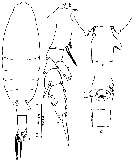 issued from : Mulyadi in Published by Res. Center Biol., Indonesia Inst. Sci. Bogor, 2004. [p.69, Fig.38]. Female (from Indonesian Seas): a, habitus (dorsal); b, forehead (lateral); c, posterior part of last yhoracic segment and genital complex (dorsal); d, urosomites 1 and 2 (ventral); e, P2.
|
 Euchaeta concinna Euchaeta concinna Female: 1 - See Key to concinna species Group. 2 - Dorsally, genital somite asymmetrical with conspicuous outgrowth on right side (Fig.7-d); 3 - Dorsally, genital somite with toothlike outgrowth on right side (Fig.7-d). 4 - Dorsally, genital somite with conspicuous notch on left side (Fig.7-d).
|
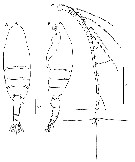 Issued from : H.Y. Soh, S.Y. Moon & J.H. Wi in Invertebrate Fauna of Korea (eds) Incheon: NIBR, 2013, 21 (28). [p.16, Fig.4]. Female (Korean waters): A-B, habitus (dorsal and lateral); C, A1. Scale bars: 500 µm.
|
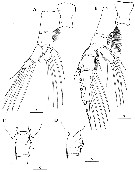 Issued from : H.Y. Soh, S.Y. Moon & J.H. Wi in Invertebrate Fauna of Korea (eds) Incheon: NIBR, 2013, 21 (28). [p.17, Fig.5]. Female: A, P1; B, P2; C, corner of last thoracic segment and genital segment (dorsal); D, same (lateral, right side) Scale bars: A, B = 100 µm; C, D = 200 µm.
|
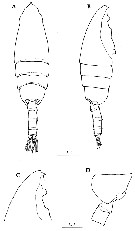 Issued from : H.Y. Soh, S.Y. Moon & J.H. Wi in Invertebrate Fauna of Korea (eds) Incheon: NIBR, 2013, 21 (28). [p.18, Fig.6]. Male: A-B, habitus (dorsal and lateral, respectively); C, head (lateral); D, posterior prosome and two urosomal proximal segments (lateral). A, B = 500 µm; C, D = 200 µm.
|
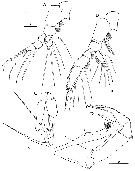 Issued from : H.Y. Soh, S.Y. Moon & J.H. Wi in Invertebrate Fauna of Korea (eds) Incheon: NIBR, 2013, 21 (28). [p.19, Fig.7]. Male: A, P1; B, P2; C, P5; D, distal segments of left P5.
|
 Issued from: Q.-c Chen & S.-z. Zhang in Studia Marina Sinica, 1965, 7. [p.130 ]. Comparison of distinguished features between E. concinna forma typica and E. concinna forma consimilis. Nota: Farran (1936) in describing Euchaeta consimilis as a new species also stated that it is very similar to Euchaeta concinna, and thet the differnces between the two species are essentially insignificant. The authors consider ir an infrasubspecific form of Euchaeta concinna. The female specimens from the East China Sea can be distinguished into two forms: typica and consimilis.
|
 Issued from: Q.-c Chen & S.-z. Zhang in Studia Marina Sinica, 1965, 7. [p.131 ]. Comparison of distinguished features between E. concinna forma typica and E. concinna forma consimilis.
| | | | | Compl. Ref.: | | | Carl, 1907 (p.16); Sewell, 1948 (p.422, 427, 433, 442, 463); De Decker & Mombeck, 1964 (p.12); Vinogradov, 1968 (1970) (p.277); Delalo, 1968 (p.137); Itoh, 1970 a (p.4: tab.1); Timonin, 1971 (p.281, trophic group); Gueredrat, 1971 (p.300, fig.2, 10, Table 1, 2); Casanova, 1973 (p.513, Rem.); Heinrich, 1973 (p.95); Patel, 1975 (p.659); Tranter, 1977 (p.596, 599); Arashkevich, 1978 (p.118, Table: diets); Stephen & Iyer, 1979 (p.228, tab.1, 3, 4, figs.3, 4); Chen Q-c, 1980 (p.795); Sreekmaran Nair & al., 1981 (p.493, Fig.2 cont.); Uye S-i., 1982 (p.149, relation length-weight-C-N); Kovalev & Shmeleva, 1982 (p.83); Dessier, 1983 (p.89, Tableau 1, Rem., %); Guangshan & Honglin, 1984 (p.118, tab.); Almeida Prado Por, 1985 (p.250); Moraitou-Apostolopoulou, 1985 (p.303, occurrence/abundance in E Mediterranean Sea, Rem.: p.313); Madhupratap & Haridas, 1986 (p.105, tab.1); Sarkar & al., 1986 (p.178); Echelman & Fishelson, 1990 a (tab.2); Dai & al., 1991 (tab.1); Yoo, 1991 (tab.1); Shih & Young, 1995 (p.70); Padmavati & Goswami, 1996 a (p.85, fig.3); Go & al., 1997 (tab.1); Ramaiah & Nair, 1997 (tab.1); Park & Choi, 1997 (Appendix); Hsieh & Chiu, 1998 (tab.2); Noda & al., 1998 (p.55, Table 3, occurrence); Padmavati & al., 1998 (p.349); Achuthankutty & al., 1998 (p.1, Table 2, seasonal abundance vs monsoon); Mauchline, 1998 (tab.33, 35, 36, 42); Lo & al., 2001 (1139, tab.I); Hwang & al., 2003 (p.193, tab.2); Hsiao & al., 2004 (p.326, tab.1); Hsieh & al., 2004 (p.397, tab.1); Rezai & al., 2004 (p.490, tab.2); Lan & al., 2004 (p.332, tab.1, tab.2); Yin & al., 2004 (p.3); Lo & al., 2004 (p.89, tab.1); Wang & Zuo, 2004 (p.1, Table 2, dominance, origin); Kazmi, 2004 (p.229); Zenetos & al., 2005 (p.63, Rem.: p.82, casual occurrence); Zuo & al., 2006 (p.162: tab.1, 3, abundance, fig.8: stations group); Rakhesh & al., 2006 (p.93, Table 2, spatial distribution); Zhang W & al., 2006 (p.553, Table 2, grazing rates); Hwang & al., 2006 (p.943, tabl. I); Kovalev, 2006 (p.67: Lessepsian migration); Hwang & al., 2007 (p.24); Dur & al., 2007 (p.197, Table IV); Jitlang & al., 2008 (p.65, Table 1); Lan Y.C. & al., 2008 (p.61, Table 1, % vs stations, Table 2; indicator species); Tseng L.-C. & al., 2008 (p.153, Table 2, fig.5, occurrence vs geographic distribution, indicator species); Fernandes, 2008 (p.465, Tabl.2); C.-Y. Lee & al., 2009 (p.151, Tab.2); Zhang W & al., 2009 (p.261); Lan & al., 2009 (p.1, Table 2); Jiang Z.-B. & al., 2009 (p.196, Table 1, 2); Hwang & al., 2009 (p.49, fig.4, 5); Zhang G.-T. & al., 2010 (p.492, Table 1); Cornils & al., 2010 (p.2076, Table 3); Sun & al., 2010 (p.1006, Table 2); Zenetos & al., 2010 (p.397); W.-B. Chang & al., 2010 (p.735, Table 2, abundance); Hsiao S.H. & al., 2011 (p.475, Appendix I); Hsiao & al., 2011 (p.317, Table 2, 3, fig.6, indicator of seasonal change); Maiphae & Sa-ardrit, 2011 (p.641, Table 2); Zhaoli & al., 2011 (p.84, abundance %); Chen H; & al., 2011 (p.84, spatial & temporal variations); Pillai H.U.K. & al., 2011 (p.239, Table 3, vertical distribution); Guo & al., 2011 (p.567, table 2, indicator); Mulyadi & Rumengan, 2012 (p.202, Rem.: p.204); Huo & al., 2012 (p.1, Table 1: dominance); Dorgham & al., 2012 (p.473, Table 4: abundance vs season); Jang M.-C & al., 2012 (p.37, abundance and seasonal distribution); Wong C.K. & al., 2012 (p.1, seasonal distribution, vertical distribution, feeding behavior); Tseng & al., 2013 (p.507, seasonal abundance); Hwang & al., 2014 (p.43, Appendix A: seasonal abundance) | | | | NZ: | 11 | | |
|
Distribution map of Euchaeta concinna by geographical zones
|
| | | | | | | | | | | |  issued from : C.T. Achuthankutty, N. Ramaiah & G. Padmavati in Pelagic biogeography ICoPB II. Proc. 2nd Intern. Conf. Final report of SCOR/IOC working group 93, 9-14 July 1995. Workshop Report No. 142, Unesco, 1998. [p.8, Fig.6]. issued from : C.T. Achuthankutty, N. Ramaiah & G. Padmavati in Pelagic biogeography ICoPB II. Proc. 2nd Intern. Conf. Final report of SCOR/IOC working group 93, 9-14 July 1995. Workshop Report No. 142, Unesco, 1998. [p.8, Fig.6].
Salinity ranges for E. concinna in coastal and estuarine waters of Goa (India).
Shaded area indicates the range of higher abundance. |
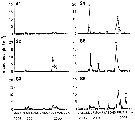 Issued from : C.K. Wong, E.Y.W. Yau & A.A.Y. Lie in Aquatic Ecosystems, 2012 (8). [p.5, Fig.3]. Issued from : C.K. Wong, E.Y.W. Yau & A.A.Y. Lie in Aquatic Ecosystems, 2012 (8). [p.5, Fig.3].
Temporal variation in the mean density (± Standard deviation) of P. concinna in Tolo Harbour (S1 & S2) and Mirs Bay (S3 & S4) and southeastern Hong Kong waters (S5 & S6: stations offshore) |
 Issued from : C.K. Wong, E.Y.W. Yau & A.A.Y. Lie in Aquatic Ecosystems, 2012 (8). [p.4, Fig.2]. Issued from : C.K. Wong, E.Y.W. Yau & A.A.Y. Lie in Aquatic Ecosystems, 2012 (8). [p.4, Fig.2].
Seasonal variations in surface water temperature and salinity. Values are mean (± S.D.) of the six (S1 to S6) sampling stations in Hong Kong waters. |
 Issued from : C.K. Wong, E.Y.W. Yau & A.A.Y. Lie in Aquatic Ecosystems, 2012 (8). [p.5, Fig.4]. Issued from : C.K. Wong, E.Y.W. Yau & A.A.Y. Lie in Aquatic Ecosystems, 2012 (8). [p.5, Fig.4].
Relationship between the density of P. concinna and surface water temperature and salinity.
Size of the circles represents the density range. |
 Issued from : C.K. Wong, E.Y.W. Yau & A.A.Y. Lie in Aquatic Ecosystems, 2012 (8). [p.7, Fig.7]. Issued from : C.K. Wong, E.Y.W. Yau & A.A.Y. Lie in Aquatic Ecosystems, 2012 (8). [p.7, Fig.7].
Diel variations in the gut fullness index (± S.D.) of female P. concinna at different layers of the water column.
Grey shading represents nightime. n = 10 for each data point. |
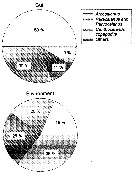 Issued from : C.K. Wong, E.Y.W. Yau & A.A.Y. Lie in Aquatic Ecosystems, 2012 (8). [p.8, Fig.8]. Issued from : C.K. Wong, E.Y.W. Yau & A.A.Y. Lie in Aquatic Ecosystems, 2012 (8). [p.8, Fig.8].
Composition of copepods in the gut of female P. concinna and in the environment in Hong Kong waters. |
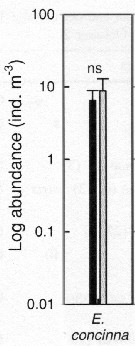 Issued from : S.-H. Hsiao, S. Kā, T.-H. Fang & J.-S. Hwang inHydrobiologia, 2011, 666. [p.326, Fig.6]. Issued from : S.-H. Hsiao, S. Kā, T.-H. Fang & J.-S. Hwang inHydrobiologia, 2011, 666. [p.326, Fig.6].
Variations in the most abundant copepod species (mean ± SE) along the transect in the boundary waters between the northern part Taiwan Strait and the East China Sea i March (black bar) and October (grey bar) 2005 (Mann-Whitney U test, sig. ns: P >0.05.
See drawings of Hydrological conditions and superficial marine currents in Calanus sinicus. |
 Issued from : T. Zuo, R. Wang, Ya-qu. Chen, Sh-wu Gao & Ke. Wang in J. Mar. Syst., 2006, 59. [p.170, Fig.9H]. Euchaeta concinna Issued from : T. Zuo, R. Wang, Ya-qu. Chen, Sh-wu Gao & Ke. Wang in J. Mar. Syst., 2006, 59. [p.170, Fig.9H]. Euchaeta concinna
Spatial of representative species abundance with isobaths shown in gray.
The circles are proportional in diameter to square root value of abundance.
Copepods collected vertically with plankton net (200 µm mesh aperture) from a depth near the bottom to the surface in autumn 2000 (18 October to 21 November).
Body length (mm): 3.03. |
| | | | Loc: | | | South Africa (E), off St. Helena Is., off Ascension Is., E Medit. (Ionian Sea, Egypt, Lybia), G. of Aqaba, off Sharm El-Sheikh, Red Sea, Arabian Sea, Arabian Gulf (Kuwait), off Cochin, Bombay, Goa, G. of Mannar, Sri Lanka, Indian, India (Sarashtra coast, Hooghly estuary, E India, Bay of Bengal, Burma, Andaman Sea (Barren Island), W Malay Peninsula (Andaman Sea), W Australia, Straits of Malacca, Indonesia-Malaysia, Ambon Bay, Flores Sea, Tioman Is., S Celebes Sea, Viet-Nam, Hainan (Sanya Bay), Hong Kong, China Seas (Bohai Sea, Yellow Sea, East China Sea, South China Sea, Changjiang River estuary, Xiamen Harbour), Taiwan Strait, Taiwan (S, E, SW, W, NW, NE, off Danshuei River), Okinawa, S & E Korea, Korea Strait, Japan Sea, Japan, Kuchinoerabu Is., Inland Sea, off SE Japan, Pacif. (E-W equatorial), Australia (G. of Carpentaria, Great Barrier, Moreton Bay, Shark Bay, North West Cape), New Caledonia, Peru, Easter Is. | | | | N: | 131 | | | | Lg.: | | | (3) F: 2,52-2,1; M: 2,3; (29) F: 2,872; M: 2,534; (34) F: 3,4-3,25; M: 2,76-2,54; (34) F: 2,67-2,36; (47) F: 3,3; M: 2,75; (63) F: 3,3-2,99; M: 2,52; (91) F: ± 3; (98) F: 3,38-2,59; M: 3,1-2,49; (99) F: 3,25-2,87; M: 2,8-2,59; (101) F: 2,55-2,52; M: 2,24; (104) F: 3,75; M: 2,6; (290) F: 3,05-3,10 (f. typica; 3,10-3,35 (f. consimilis); M: 2,45-2,6; (334) F: 3,75; M: 2,6; (530) F: 3; M: 2,8; (1085) F: 3,10-3,15; M: 2,61-2,68; (1106) F: 2,88-3,21; M: 2,48-2,75; (1122) F: 3,1; (1174) F: 2,88-3,21; M: 2,48-2,75; {F: 2,10-3,75; M: 2,24-3,10}
The mean female size is 3.016 mm (n = 29; SD = 0.3861), and the mean male size is 2.620 mm (n = 20; SD = 0.1950). The size ratio (male : female) is 0.85 (n = 6; SD = 0.0564), or ± 85 %. In samples, the sex ratio (female : male) is temporary 1.214. | | | | Rem.: | epipelagic.
For Park (1995, p.18) the species belongs to ''concinna'' Group, characterised by: 1st inner lobe of Mx1 with 1 or 2 proximal marginal setae. Only 1 endopodal seta of Mx2 armed with long spinules in addition to rows of small spinules. 3rd exopodal segment of male left P5 without a poorly sclerotized lobe next to tufts of stiff hairs.
According to Grice (1962, p.201) Farran (1936) described Euchaeta consimilis from females collected near the Great Barrier Reef; he also found E. concinna only inside the reef where it was one of the most characteristic of the copepods; according to Farran, consimilis differs morphologically from concinna in the form of the protrusion on the right side of the genital segment in the female. Sewell (1929) observed ''a considerable degree of variation'' in the form of the genital protrusion in concinna collected in the Indian Ocean; this author suggested that this variation may be correlated with egg laying which causes the protrusion to increase in size.
Park (1995) does neither retain the presence of this species in the Atlantic in Wolfenden (1911), nor in the eastern Mediterranean (Casanova, 1973), but maybe mistakenly as it could be an example of Lessepsian migrations (cf. Halim, 1990, p.11). In the samples world-wide studied, Park found this species only in the Malay Archipelago.
Farran (1936, p.90) catchs outside of the reef few specimens females of a smaller size (2.36-2.67 mm) than E. concinna, which closely resembles it, but seems specifically distinct; the grounds for separating the smaller species lie in the size, cooupled with a difference in distribution and a difference in the form of the projection on the right side of the genital segment in dorsal view. The appendages do not differ from those of E. concinna. Sewell (1929) records the measurements of a large number of specimens from a single station; these cover, for the females, a range of 2.5-3.5 mm, and comments on the degree of variation in the size of the projection on the right side of the genital segment.
For Itoh (1970 a, fig.2, from co-ordonates) the Itoh's index value of the mandibular gnathobase = 820.
Timonin (1971, p.282) considers the trophic interrelations in the equatorial and tropical Indian Ocean, and divides the plankters into 6 trophic groups from the litterature and the results of studies of mouth-parts structure and intestine content. This species is a seizing and masticating carnivorous. | | | Last update : 09/12/2020 | |
|
|
 Any use of this site for a publication will be mentioned with the following reference : Any use of this site for a publication will be mentioned with the following reference :
Razouls C., Desreumaux N., Kouwenberg J. and de Bovée F., 2005-2025. - Biodiversity of Marine Planktonic Copepods (morphology, geographical distribution and biological data). Sorbonne University, CNRS. Available at http://copepodes.obs-banyuls.fr/en [Accessed December 03, 2025] © copyright 2005-2025 Sorbonne University, CNRS
|
|
 |
 |








































